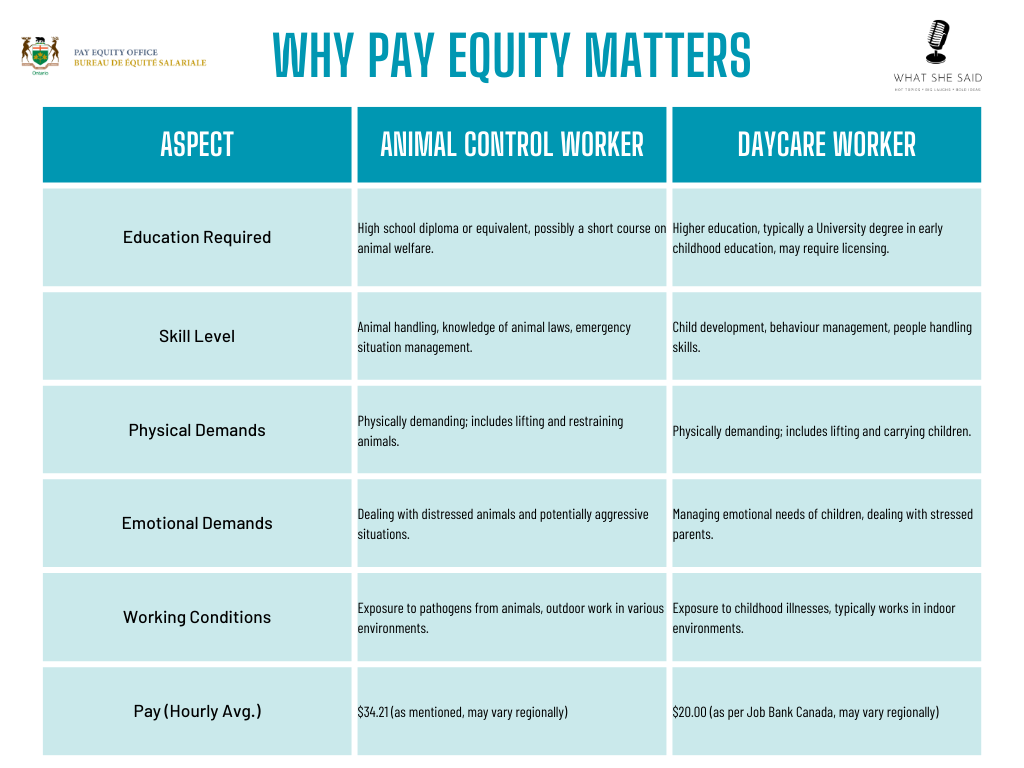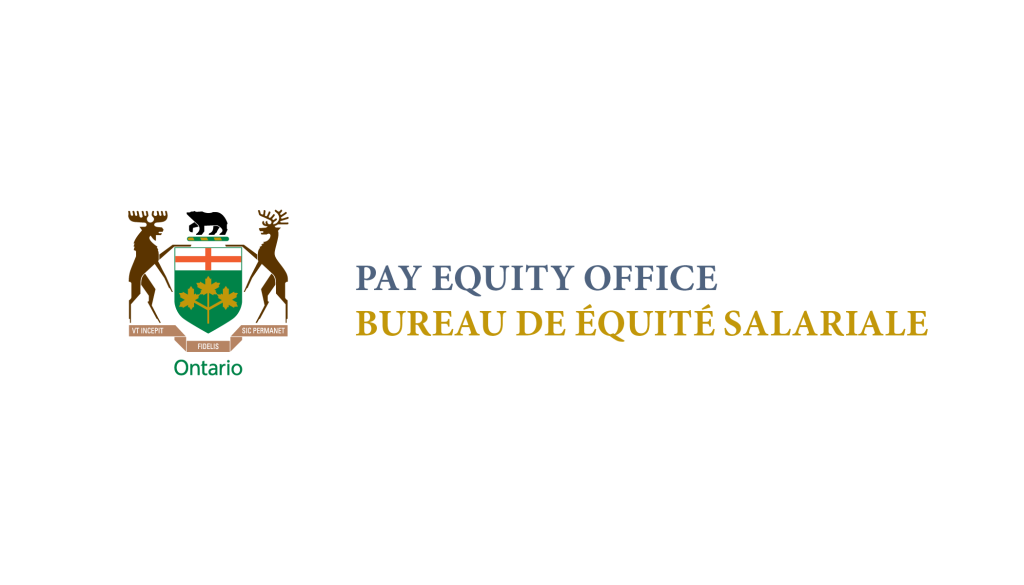In the most recent interview in What She Said’s ongoing series with Ontario’s Pay Equity Office,
I asked to have pay equity versus equal pay explained to me. I’m not even a little bit embarrassed about this, mostly because there are governments around the world that still struggle with this concept. In my mind though, I always assumed it was like empathetic and empathic; they sound a little different but essentially mean the same thing. However, it turnsout there’s a significant distinction, which makes sense given it’s called the Pay Equity Office, not the Pay Equality Office. So, why is that?
Well, first off, equal pay for equal work is already mandated and enforced in Canada, which essentially means that employers must pay the same wage to employees who perform the same job under similar working conditions, regardless of their gender or other identities. This policy targets the straightforward concept of fairness in paying someone the same amount as others doing the same job. However, pay equity takes a broader perspective. It’s about compensating work of equal value appropriately, which includes different job types that may be traditionally undervalued. For instance, jobs predominantly held by women, like nursing or teaching, are compared to those traditionally dominated by men, to ensure equitable pay across the board. This approach not only addresses direct pay discrepancies but also tackles systemic gender biases affecting job valuation and compensation.
Pay Equity Versus Equal Pay
In our exploration of pay equity versus equal pay, it’s essential to understand that while equal pay addresses the straightforward issue of ensuring that individuals in the same job role with the same responsibilities are paid equally, pay equity goes deeper into the value of different but comparable roles. This broader perspective examines whether diverse positions that contribute similarly to an organization are remunerated fairly, even if the job functions differ. For example, let’s consider two distinct roles: an animal control officer and a daycare worker. These positions vary significantly in daily tasks and requirements but share comparable levels of skill, responsibility, and impact. By comparing these roles, we can shed light on the nuanced distinctions between equal pay and pay equity.

The comparison between an animal control officer and a daycare worker, as illustrated above, underscores the critical need for pay equity. Despite the clear differences in their work environments and specific duties, both roles demand similar levels of skill, effort, and emotional resilience, yet there is a stark contrast in their compensation. This disparity highlights why pay equity is crucial; it ensures that jobs providing comparable value receive equitable remuneration. Examining examples like these not only clarifies the distinction between pay equity and equal pay but also advocates for a fairer and more just compensation system where roles of equivalent value are equally valued, financially.
Why Does This Matter
Understanding and implementing the principles of pay equity and equal pay is not just about fulfilling legal requirements; it’s about fostering a fair, equitable, and productive workplace. These concepts are essential because they directly impact the economic stability and well-being of individuals and, by extension, the broader society. Here’s why this issue is so vital:
Firstly, pay equity promotes social justice. When pay structures are adjusted to reflect the true value of different jobs, particularly those traditionally undervalued and dominated by women or minorities, it addresses long-standing inequities. This adjustment not only benefits the individuals directly affected but also challenges and changes the systemic biases that have perpetuated gender and racial wage gaps. Ensuring that everyone is compensated fairly for their contributions uplifts entire communities by reducing poverty and enhancing quality of life.

Secondly, and this one is crucial for employers to hear, embracing pay equity can significantly enhance workplace morale and productivity. Employees who feel valued and fairly compensated are more likely to be engaged, loyal, and motivated. This is not just beneficial for the individuals but for the organization as a whole. Higher job satisfaction reduces turnover rates, lowers recruitment costs, and boosts productivity. In essence, fair pay practices lead to a more stable and committed workforce, which is a crucial component for any successful business.

Lastly, aligning with pay equity principles is increasingly important for organizational reputation and legal compliance. In today’s digital age, companies are more visible and accountable to the public than ever before. Organizations that fail to address pay inequities may face not only legal repercussions but also damaging publicity. One TikTok about a company’s unfair practices, can take it down. A commitment to pay equity enhances a company’s image as a fair and progressive employer, attracting top talent and potentially leading to better business outcomes. As societal awareness and expectations around fair pay practices grow, being a leader in pay equity can set a company apart in a competitive market.
Mind the Gap
Now that we all understand pay equity versus equal pay, it’s crucial to reflect on what we’ve learned in our previous discussions on the gender wage gap and the necessity of pay equity. The conversations we’ve had are interconnected, each shedding light on different facets of the same crucial issue: the persistent inequalities in the workplace.

From our first discussion, Why Do We Need Pay Equity?, we understood that pay equity is not just a moral and ethical requirement but also a strategic imperative. It’s about recognizing and rectifying the historical undervaluation of jobs typically dominated by women. This conversation lays the foundation for why adjustments in pay structures are essential for achieving true workplace equality.

In the second discussion, What Is the Gender Wage Gap? A Stubborn Relic of Inequality, we examined the complexities of the gender wage gap, illustrating its stubborn persistence despite years of progress. We discussed how systemic biases and outdated workplace structures contribute to this ongoing issue.
Finally, the detailed comparison of roles in this segment, like those of an animal control officer and a daycare worker further emphasizes the practical aspects of pay equity. It highlights how different roles, when evaluated fairly, reveal significant disparities that need addressing. I don’t know how many different ways I can say but here goes; PAY EQUITY BENEFITS EVERYONE! It enhances the overall economic health of our society by ensuring everyone is compensated justly for the value they provide.

The journey towards closing these gaps continues, and each step we take is a move towards a fairer, more equitable world. Stay tuned for our next discussion on the Gender Pension Gap…because this one, this one keeps me up at night!
DISCLOSURE: THIS ARTICLE IS THE THIRD IN A THOUGHT-PROVOKING 6-PART SERIES BROUGHT TO YOU IN PARTNERSHIP WITH THE PAY EQUITY OFFICE OF ONTARIO. AS PART OF THIS COLLABORATION, I AM BEING COMPENSATED FOR MY EFFORTS TO SHED LIGHT ON THE CRUCIAL ISSUES SURROUNDING PAY EQUITY AND TO CONTRIBUTE TO THE BROADER CONVERSATION ON ACHIEVING GENDER EQUALITY IN THE WORKPLACE.
